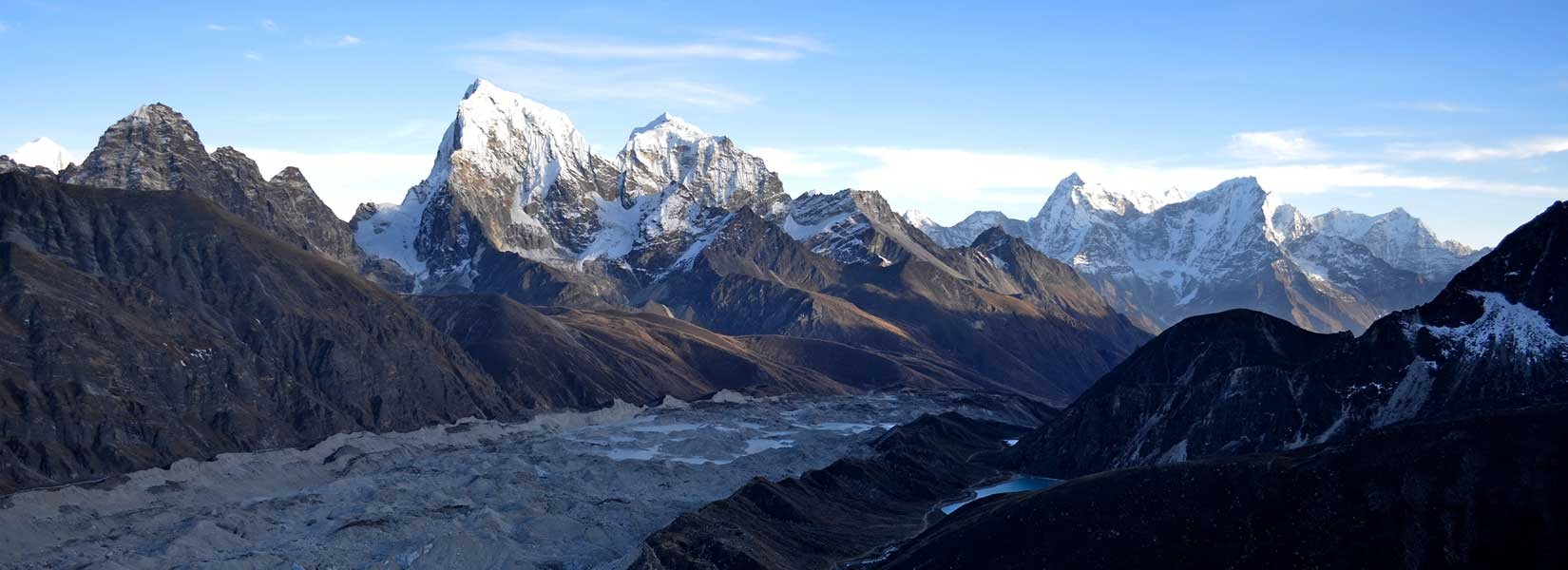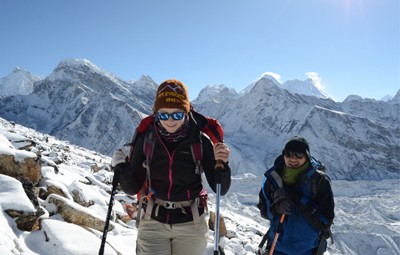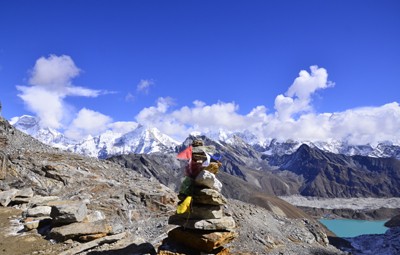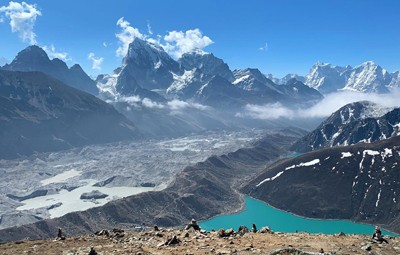Why Choose the Gokyo Lakes Trek?
The primary appeal of the Gokyo Lakes trek is its ability to provide a serene escape from the crowds. You'll experience the authentic charm of Sherpa culture in traditional villages, receiving a warm welcome at the local teahouses. While some trekkers may worry about the views, the panorama from the top of Gokyo Ri is arguably more impressive than that from Kala Patthar. From this viewpoint, you can see four of the world's highest peaks: majestic Mount Everest, along with Lhotse, Makalu, and Cho Oyu.
The trek also offers a unique opportunity to witness the massive Ngozumpa Glacier, Nepal's largest. The Gokyo trek difficulty is generally considered moderate and is less strenuous than the Everest Base Camp route. The trails are well-defined and don't involve the same steep, challenging climbs, making it more accessible for many trekkers. However, proper acclimatization and awareness of altitude sickness are still crucial, as the trek reaches a significant altitude at Gokyo village and Gokyo Ri.
Key Highlights
- Scenic Beauty: Features the stunning turquoise Gokyo Lakes and views of the massive Ngozumpa Glacier, Nepal's largest.
- Panoramic Views: The summit of Gokyo Ri offers arguably the best panoramic views in the Everest region, with sight of four of the world's highest peaks: Mount Everest, Lhotse, Makalu, and Cho Oyu.
- Crowd Avoidance: A less-traveled alternative to the crowded Everest Base Camp trek, providing a more serene and authentic experience.
- Trek Difficulty: Considered moderately difficult, it is generally less strenuous than the Everest Base Camp trek, making it more accessible to a wider range of trekkers.
- Flexibility: The trek can be done over a standard 14-day itinerary, with options to extend or combine it with Everest Base Camp via the Cho La Pass or as part of the more challenging Everest Three Passes Trek.
- Best Seasons: The optimal times to trek are during the spring (March-May) and autumn (September-November) for stable weather and clear skies.
- Essential Preparations: Requires two specific permits, a packing list focused on warm layers, and mandatory travel insurance that includes high-altitude and helicopter evacuation coverage.
- Logistics: The trek provides access to teahouses for accommodation and meals, along with basic connectivity (Wi-Fi and mobile networks) and solar charging for a fee.
How long does the Gokyo Lakes trek take? Which Itinerary is recommended?
The length of the Gokyo Lake (valley) trek can vary depending on the specific itinerary and trekking pace, but there are several common durations:
14 Days Gokyo Lakes Trek Itinerary
This is considered a standard duration. It's suitable for slow trekkers and includes important acclimatization days, as well as a "buffer day" to account for potential flight delays or cancellations at the Lukla airport. This duration often includes a cultural heritage tour in Kathmandu.
- Day 1: Arrival in Kathmandu. 1300m (4265 ft)
- Day 2: Sightseeing around Kathmandu. 1300m (4265 ft)
- Day 3: Kathmandu - Manthali Fly to Lukla (2,860 m), Trek To Phakding. 2610m (8562 ft) 7.8 km (4.8 miles) 4 hours walk.
- Day 4: Phakding to Namche Bazaar. 3440m (11286ft) 11.3 km (7 miles) – 6-7 hours walk.
- Day 5: Acclimatisation Day - Namche Bazaar. 3440m (11286ft)
- Day 6: Namche Bazaar - Phortse Thanga. 3950 m 5.7 km (3.5 miles) 6 hours walk.
- Day 7: Phortse Thanga - Machhermo. 4470 m 7.5 km (4.6 miles) 5 hours walk.
- Day 8: Machhermo - Gokyo. 4,700m (15419ft) 6.8km (4.2miles) 5 hours walk.
- Day 9: Gokyo Valley Acclimatisation Day - Hike to Gokyo Ri (viewpoint) 5,357 M (17,575 ft).
- Day 10: Gokyo Trek to Dole. 4038m 11.9 km (7.3 miles) 6-7 hours walk.
- Day 11: The Dole Trek to Namche. 3440m 12.4km (7.7 miles) 5 hours walk.
- Day 12: Namche Bazaar to Lukla. 2860m (9383 ft) 13.5km (8.3 miles) 6-7 hours walk.
- Day 13: Fly to Kathmandu. 1300m (4265 ft)
- Day 14: Final departure.
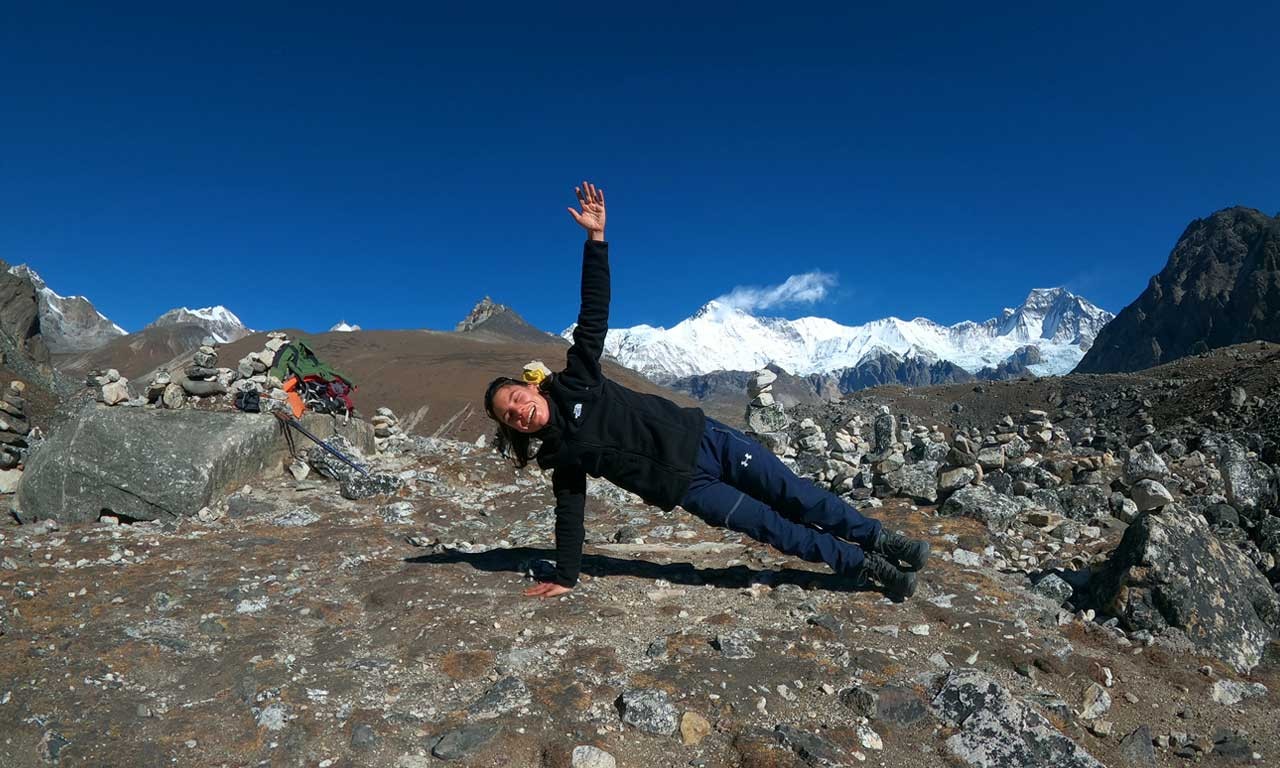
This is another popular option that includes your arrival and departure days but may require a very early morning drive to Manthali Airport (Ramechhap) during peak seasons due to air traffic in Kathmandu. 10 Days Gokyo Lake Trek Itinerary, This is a shorter option that typically counts only the trekking days from Kathmandu to Kathmandu, not including international arrival and departure.
- Day 1: Arrival in Kathmandu. 1300m (4265 ft)
- Day 2: Kathmandu - Manthali Fly to Lukla (2,860 m), Trek to Phakding. 2610m (8562 ft) 7.8 km (4.8 miles) 4 hours walk.
- Day 3: Phakding to Namche Bazaar. 3440m (11286ft) 11.3 km (7 miles) – 6-7 hours walk.
- Day 4: Acclimatisation Day - Namche Bazaar. 3440m (11286ft)
- Day 5: Namche Bazzar Trek to Dole 4,038 m (13248ft) 12.4km (7.71 miles) – 5-6 hours walk.
- Day 6: Dole Trek to Machhermo 4,470m (14665 ft) 5.6 km (3.51 miles). 4-5 hours walk.
- Day 7: Machhermo to Gokyo Lake 4,700m (15419ft) 6.8km (4.2 miles). 4-5 hours walk.
- Day 8: Gokyo Lake - Gokyo Ri (5,357m 17,575 ft) and Trek to Machhermo 4,470m (14665 ft) 8 km (4.9 miles)
- Day 9: Machhermo Trek to Namche 3440m (11286ft) 22.9km (14.2 miles) 7 hours walk.
- Day 10: Namche Bazaar to Lukla. 2860m (9383 ft) 13.5km (8.3 miles) 6-7 hours walk.
- Day 11: Fly to Kathmandu. 1300m (4265 ft)
- Day 12: Final departure.
In general, most tour operators recommend a trekking package of at least 13-14 days to ensure proper acclimatization and to have some flexibility for unforeseen delays.
What is the best time to go on the Gokyo Lakes Trek?
The best times to trek to Gokyo Lakes are during the spring (March-May) and autumn (September-November). These seasons offer clear skies, stable weather, and excellent visibility of the mountains.
- Spring (March-May): The weather is warm, and the forests are filled with blooming rhododendron flowers.
- Autumn (September-November): This season is known for crisp days, clear mountain views, and lush green scenery.
While it is possible to trek during the monsoon and winter, these seasons have an increased risk of flight delays to Lukla. In winter, heavy snowfall can also necessitate turning back from higher elevations.
Temperatures During the Gokyo Lake Trek.
The Gokyo Lake trek features a wide temperature range, from mild and pleasant at low altitudes to frigid at higher elevations. From Namche Bazaar upwards, temperatures drop, and at the Gokyo Ri, range from 2 to -15 degrees Celsius. Trekkers should pack proper layered clothing, including a down jacket, warm socks, and gloves, to stay prepared for the cold.
Trekking Gear and Packing list.
Packing appropriately is essential for the high-altitude Gokyo Lakes trek. Your packing list should focus on layers that are warm, lightweight, and comfortable. Key items include a high-quality down jacket, thermal base layers, warm trekking pants, and sturdy hiking boots. Don't forget accessories like gloves, a hat, and warm socks. Additionally, a headlamp, a power bank for charging devices, necessary medications, and personal toiletries are crucial for a safe and comfortable journey.
How difficult and dangerous is the Gokyo Lakes Trek?
Gokyo lake elevation is 4700 m (15419 ft) and the Gokyo Lakes Trek is generally considered moderately difficult, a more manageable option than the Everest Base Camp trek. The main challenges are the high altitude, the rugged and rocky terrain, and the steep climbs and descents. It's a journey that requires a slow, steady pace to properly acclimatize. While any high-altitude trek has inherent risks, thousands of people successfully complete this trek annually, and serious incidents are very rare, usually tied to natural disasters or a lack of proper guidance. To ensure a safe experience, it's essential to trek with proper guidance and be well-prepared.
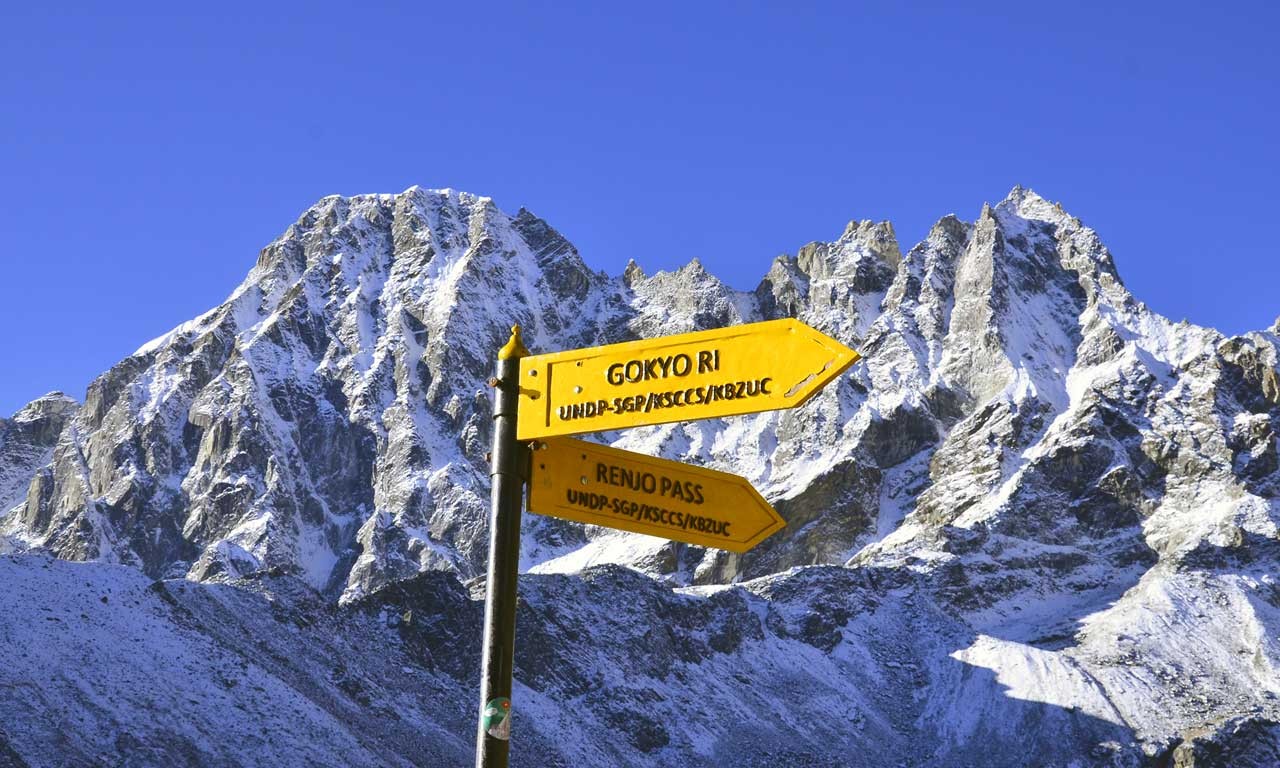
Understanding and Preventing Acute Mountain Sickness (AMS) on the Gokyo Lakes Trek
Acute Mountain Sickness (AMS) can affect anyone regardless of age or fitness level, occurring when the body fails to acclimatize to high altitudes. On the Gokyo Lakes trek, symptoms of AMS are common and can become serious if ignored. Traveling with a local guide is highly recommended to ensure safety.
Common Symptoms of AMS:
- Headache (Make sure it is common or not—consult with your guide)
- Loss of appetite, nausea, and vomiting
- Fatigue and dizziness
- Difficulty sleeping
- Increased heart rate and shortness of breath
Key Preventive Measures:
- Stay Hydrated: Drink 4-5 liters of water daily, especially above 3,000 meters.
- Rest: Take frequent breaks and get plenty of rest.
- Eat Well: Maintain a high-calorie diet. (even if you don’t feel like eating)
- Stay Warm: Dress in layers to keep your body warm.
- Descend: If you experience multiple symptoms, speak with your guide and immediately descend to a lower altitude.
Consult a Professional: Consider consulting a doctor about preventive medications like Diamox before your trek.
Accommodations and Food on the Gokyo Lakes Trek: A Helpful Guide
Gokyo Lake trek is a tea house trek where you can stay in proper lodges, hotels, and Tea houses with delicious Meals. In lower elevations up to Namche Bazaar, lodges are modern with amenities like hot showers, attached bathrooms, and Wi-Fi. As you trek higher, you'll stay in traditional tea houses with simpler, cozy rooms. These lodges have shared bathrooms but offer amazing mountain views and excellent service. Since there are fewer teahouses in higher villages, it's smart to book in advance.
Food During The Trek
For food, you can enjoy both Nepali cuisine and international dishes. The menus offer everything from traditional Dal Bhat to Western favorites. They also cater to vegetarian, vegan, and gluten-free meals. Just inform your local travel agency beforehand so they can arrange your specific dietary needs.
Drinking Water During The Trek
To ensure safe hydration on the Gokyo Lakes trek, you have three main options: treat glacier water with purification tablets, buy bottled mineral water (prices rise with altitude), or purchase boiled water from teahouses. Having a plan for safe drinking water is essential for preventing acute mountain sickness.
Electricity and WIFI During The Trek
For the Gokyo Lakes trek, expect decent mobile networks and Wi-Fi via local SIM cards or paid teahouse services, though connections weaken at higher altitudes. Electricity is available in lower villages, and higher teahouses offer solar charging for a fee.
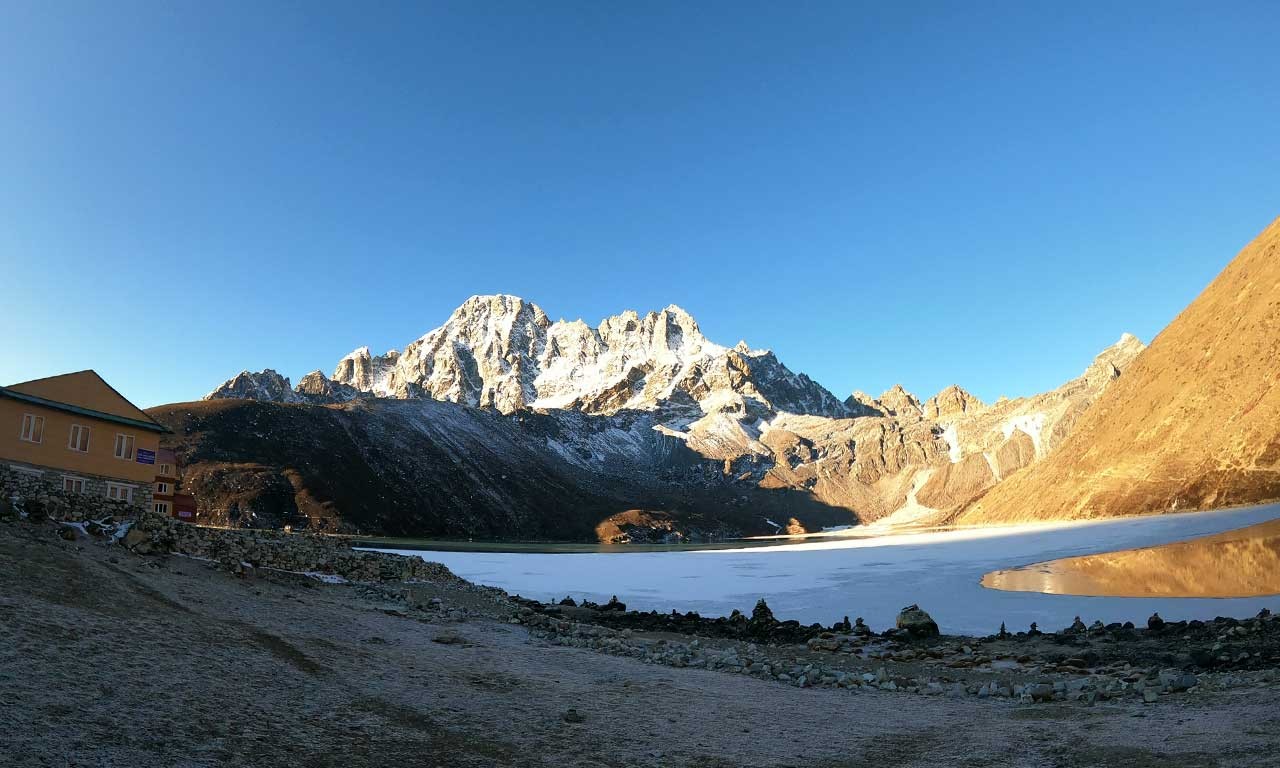
What are the required permits for the Gokyo Lakes trek?
For the Gokyo Lakes trek, you need two essential permits, which are required for all routes in the Everest region. The first is a local permit from the Khumbu Pasang Lhamu Rural Municipality, and the second is the Sagarmatha National Park entry fee. The previously required TIMS card is no longer necessary.
The costs for these permits are as follows:
Sagarmatha National Park Fee:
- For SAARC nationals: Rs. 1,500
- For other countries: Rs. 3,000
Khumbu Pasang Lhamu Rural Municipality Fee:
- Rs. 2,000 for SAARC and Chinese
- Rs. 3,000 for other Nationalities.
Both permits can be obtained directly at checkpoints along the trekking route (the Rural Municipality permit in Lukla and the National Park fee in Monjo), so there is no need to purchase them in advance.
Is travel insurance necessary for the Gokyo Lakes trek, what specific coverage is required, and are there any recommended companies?
Yes, travel insurance is an absolute necessity for the Gokyo Lakes trek, just as it is for any high-altitude trekking in Nepal. The primary reason is for your safety in case of a medical emergency in a remote area.
Here's what you need to look for in a policy:
- High-Altitude Coverage: Ensure your policy explicitly covers trekking up to a minimum of 6,000 meters (around 19,700 feet). The Gokyo Ri summit is at 5,360m, so this is a crucial detail to verify.
- Emergency Helicopter Evacuation: This is a non-negotiable part of your coverage. In the event of severe altitude sickness (AMS) or injury, a helicopter is often the only way to get a trekker to a hospital quickly, and the costs can be thousands of dollars.
- Medical Expenses: The insurance should cover medical treatment and hospitalization costs for any illness or injury sustained during your trip.
- Trip Cancellation/Interruption: This protects your financial investment if you have to cancel or cut your trek short due to unforeseen circumstances like bad weather, an illness, or other personal emergencies.
- Lost or Damaged Baggage: While not a life-or-death matter, this can save you significant hassle and expense if your gear is lost or delayed.
While it's impossible to recommend a single "best" company, reputable providers that our previous customers have successfully used for claims in Nepal include World Nomads, Global Rescue (especially for evacuation services), and Allianz Global Assistance.
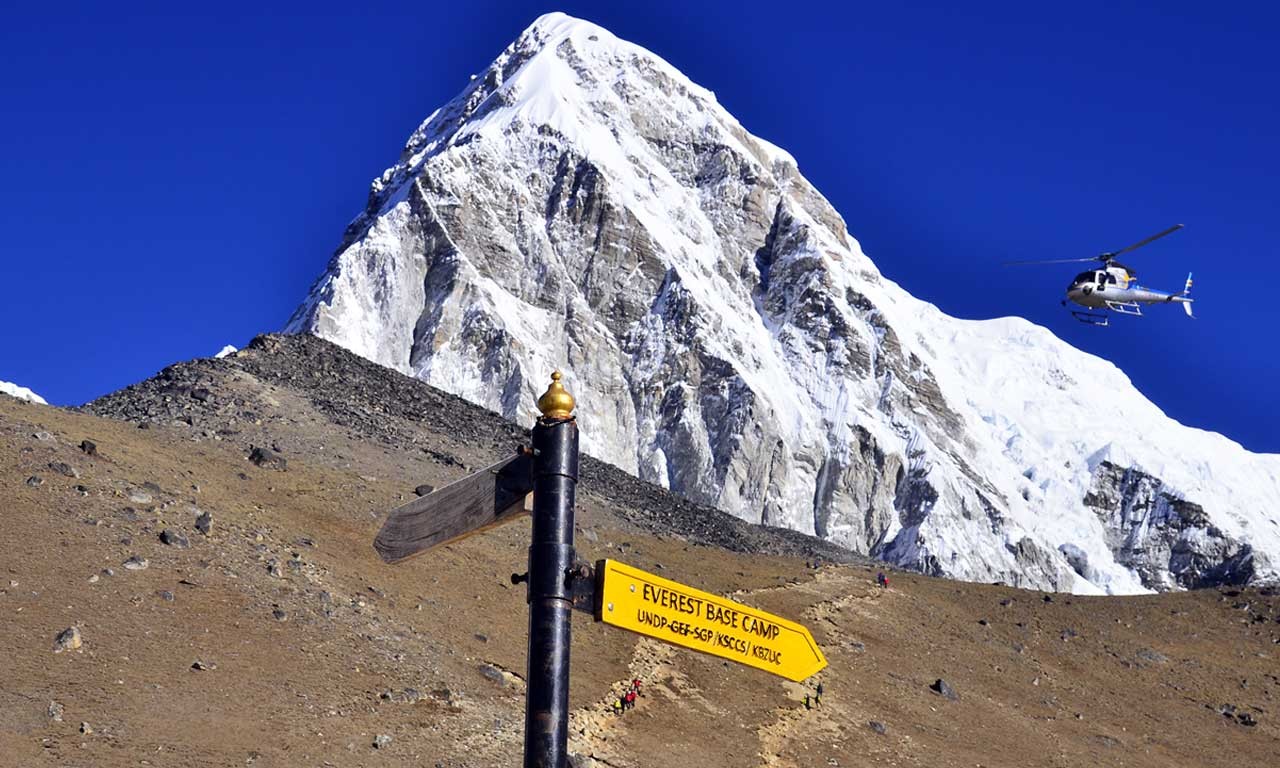
Can i extend or combine the Gokyo Lake hike with Everest Base Camp? what are the options?
Yes, you can absolutely combine the Gokyo Lakes trek with Everest Base Camp, and there are several fantastic options to do so. This combination offers a comprehensive and highly rewarding experience, allowing you to witness both the serene beauty of the Gokyo Valley and the iconic views of Everest Base Camp.
Here are the main options for combining these three treks:
This is the most popular and challenging option. It involves crossing the high-altitude Cho La Pass (5,420m), which connects the Gokyo Valley with the main Everest Base Camp trail. This route is considered strenuous and is best suited for experienced trekkers with a good level of fitness and proper acclimatization. It offers an incredible sense of accomplishment and spectacular scenery.
This is the most demanding and comprehensive route. It's a challenging circuit that includes three high passes: Renjo La, Cho La, and Kongma La. This trek incorporates the highlights of the Gokyo Valley, Everest Base Camp, and Kala Patthar, providing an in-depth exploration of the entire Khumbu region. This is ideal for highly experienced and adventurous trekkers.
Gokyo Lakes and Everest Base Camp without a Cho La Pass
For those who want to combine both destinations but prefer to avoid the technical challenge of a high pass, there's an option to trek to Gokyo and then retrace your steps back down to the main trail to connect with the Everest Base Camp route. While this route is longer and less of a circuit, it still allows you to experience the best of both valleys without the extra physical demands of crossing a pass.
Trek Itinerary of Gokyo Lake Everest Base Camp Trek
- Day 1: Arrival in Kathmandu. 1300m (4265 ft)
- Day 2: Sightseeing around Kathmandu. 1300m (4265 ft)
- Day 3: Kathmandu - Manthali Fly to Lukla (2,860 m), Trek To Phakding. 2610m (8562 ft) 7.8 km (4.8 miles) 4 hours walk.
- Day 4: Phakding trek to Namche Bazaar. 3440m (11286ft) 11.3 km (7 miles) – 6-7 hours walk.
- Day 5: Acclimatization Day - Namche Bazaar. 3440m (11286ft)
- Day 6: Namche Bazaar trek to Phortse Thanga. 3950 m 5.7 km (3.5 miles) 6 hours walk.
- Day 7: Phortse Thanga trek to Machhermo. 4470 m 7.5 km (4.6 miles) 5 hours walk.
- Day 8: Machhermo trek to Gokyo. 4,700m (15419ft) 6.8km (4.2miles) 5 hours walk.
- Day 9: Gokyo Valley Acclimatisation Day - Hike to Gokyo Ri (viewpoint) 5,357 M (17,575 ft).
- Day 10: Gokyo Trek to Phortse Village 3,810m (12,497ft) 16.5 km (10.3 miles) 7-8 hours walk.
- Day 11: Phortse Village Trek to Dingboche. 4410m 14,465ft. 17 km (10.5 miles) 6-7 hours walk.
- Day 12: Dingboche acclimatization. Day hike to Nagarjuna Hill. 4.5 km (2.7 miles). 4-5 hours walk.
- Day 13: Dingboche trek to Lobuche 4910m (16,860ft). 8 km (4.9km). 5-6 hours walk.
- Day 14: Lobuche trek to Gorak Shep 5,140m (16,105ft) and day visit to Everest Base Camp 5,364 (13,908ft). 12 km (7.4 miles). 7 to 8 hours walk.
- Day 15: Morning Hike Kala Patthar 5550 m (18,204ft) and descend to Pheriche 4,240m (13,908ft) 12km (7.4miles). 6-7 hours walk.
- Day 16: Pherice trek to Namche 3440m (11,284ft) 19 km(11.8miles). 7-8 hours walk.
- Day 17: Namche Bazaar to Lukla. 2860m (9383 ft) 13.5km (8.3 miles) 6-7 hours walk.
- Day 18: Fly to Kathmandu. 1300m (4265 ft)
- Day 19: Final departure.
We can help you craft a customized itinerary based on your fitness level, time frame, and desired level of challenge.
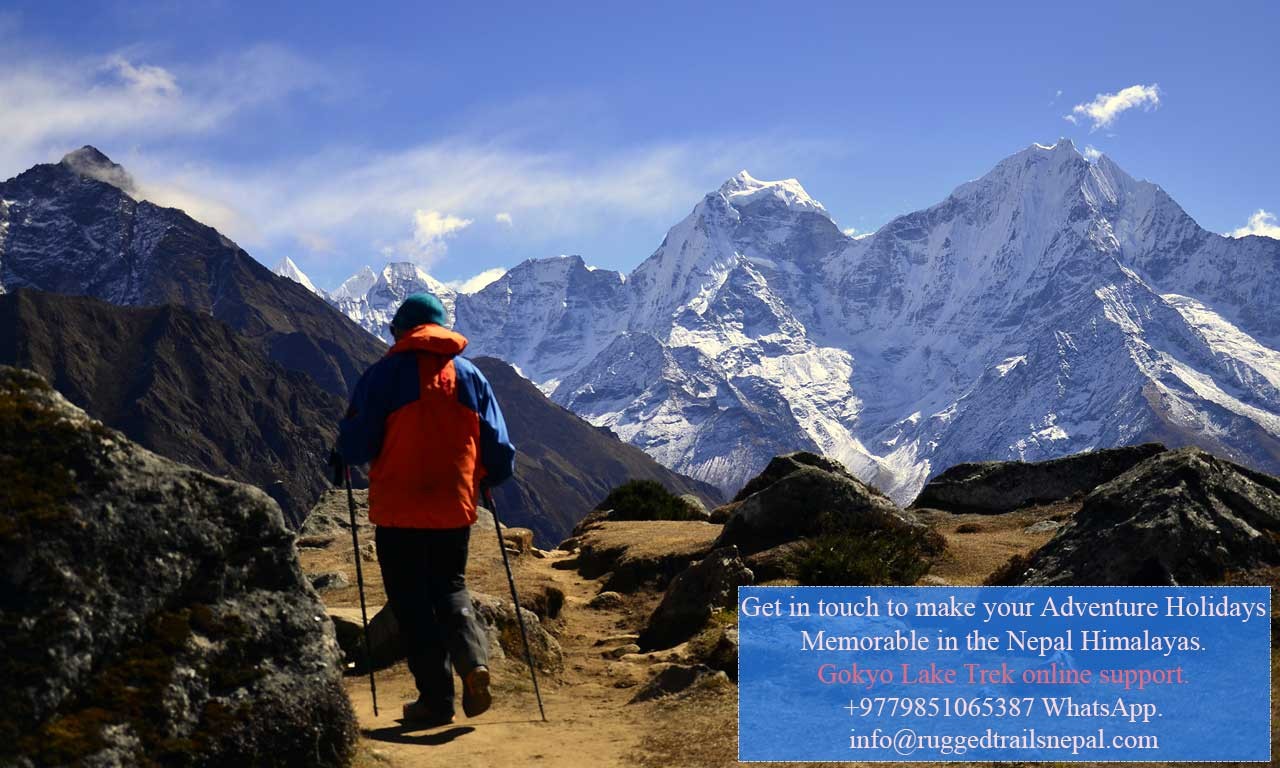
What is the Cost of the Gokyo Lake Trek?
The cost of the Gokyo Lake trek is highly variable and depends on several factors, including the number of trekking days, the standard of hotels, group size, and whether you are trekking solo or with a guide and porter. While package costs for a private booking can start from around $1,200 USD, a detailed cost breakdown is essential for a clear understanding. The cost typically covers permits, guides, porters, accommodation, and meals, but dosen't exclude personal expenses like hot showers, device charging, and alcoholic beverages. Therefore, it is important to clarify what is included and excluded in any given package to avoid unexpected costs. Private Gokyo Lake (Valley) trek bookings are open for 2025 and 2026; we simply don't focus on group departures, but if you are already in a group, we will be happy to offer you a group discount rate.
Nepal Gokyo lake Nepal Trek Cost in 2025 and Spring 2026 Including Indian Nationalities
| 12 Days Gokyo Lake Trek | Trip Cost in USD | Trip Cost in INR | 14 Days Gokyo Lake Trek | Trip Cost in USD | Trip Cost in INR |
| 1 Pax | 1570 $ | 110512 INR | 1 Pax | 1738 $ | 130200 INR |
| 2 Pax | 1175 $ | 81725 INR | 2 Pax | 1322 $ | 89775 INR |
The Gokyo Lake Trek costs cover accommodation and meals during the trek, transportation, Lukla flight tickets, a guide and Sherpa porter, and the Gokyo Lake Trek permit. The price for the Gokyo Lake Trek is considerably lower for Indian citizens than for other foreigners due to a difference in Lukla airfare.
Conclusions of Gokyo Lake Trek Details and Difficulty
The Gokyo Lakes Trek stands out as a superior and less-crowded alternative to the Everest Base Camp route, offering a unique blend of breathtaking scenery and cultural immersion. It is a moderately difficult trek that is more accessible than its famous counterpart, yet still demands proper preparation and acclimatization for safety. With flexible itinerary options, the ability to combine with other Everest routes, and essential amenities like teahouses and basic connectivity, the Gokyo trek is an excellent choice for those seeking an unforgettable high-altitude adventure with unparalleled photographic opportunities. Proper packing, a strong awareness of AMS prevention, and essential permits and insurance are the keys to a successful and safe journey.

